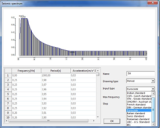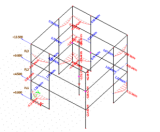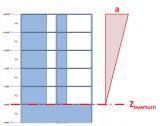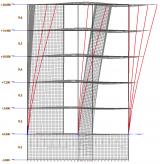Highlights
- Response of a structure under seismic load can be calculated via the response spectrum method or the equivalent lateral forces (ELF) method
- The response spectra of the EC 8, DIN (German standard), SIA (Swiss standard) and the Turkish standard are available by default.
- User can also manually define his own response spectra.
Response Spectra calculation
- Type of modal superposition: SRSS or CQC method can be selected
- Mode filtering based on modal mass
- Accidental eccentricity can be taken into account for buildings
- Automatic generation of Newmark seismic combinations
- Results from modal analysis are available: eigen frequencies, mass participation factors and eigenmode shapes
- The same postprocessing menus as for static load cases are available to view numerical or graphical results: displacements, accelerations, internal forces, and reactions.
- Results per storey are also available.
- Spectra of the EC8 and national codes: Austria, Czech Republic, France, Germany, India, Italy, Slovakia, Netherlands, Romania, Switzerland, and U.S. are available by default
- Additional spectrum can be defined using table input (copy/paste from Excel is also possible).


Equivalent Lateral Forces
The seismic Equivalent Lateral Forces (ELF) analysis is the most well-known method for the seismic analysis of structures. Although it is quite conservative, its simplicity makes it a very popular method for seismic design.
- The ELF method is a static analysis method.
- The calculation is based on the distribution of masses in the structure.
- The calculation of storey forces is based on the definition of storeys as well as on the reduced system, which must therefore be defined.
Calculation of the Equivalent Lateral Forces
- The user can select the method for calculation of equivalent lateral forces. The available methods follow the European and American standards - EN 1998 and ASCE 7-10.
- ELF are calculated in the background after a modal analysis.
- Calculated equivalent lateral forces are applied as one concentrated force at the mass centre of each storey.
Possibility to select how the acceleration is distributed in the building:
- Linear distribution of accelerations (EN 1998-1 clause 4.3.3.2.3 eq. (4.11) )
- Polynomial distribution of accelerations (ASCE 7-10 12.8.3)
- Distribution of accelerations from eigenshape (EN 1998-1 clause 4.3.3.2.3 eq. (4.10) )


Application of the storey forces to the model
- The calculated storey forces are applied to the structure using the reduced system.
- The transformation matrices of the IRS method make it possible to "smear" the concentrated storey forces in such a way that the resultant of each storey force is applied at the mass centre of the corresponding storey. It is therefore not necessary to define diaphragms to apply storey forces.
- The loads are, however, applied in a distributed way to the entire storey, hence avoiding any numerical singularity, as would be the case if point loads would be applied in a conventional way.
As results, all standard result output can be used in SCIA Engineer, without any restriction. Also, because it is a static load case, none of the issues related to the loss of sign due to the modal superposition apply here.
Required modules:
- scia.a.modal
